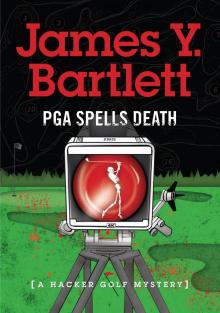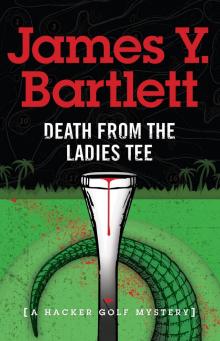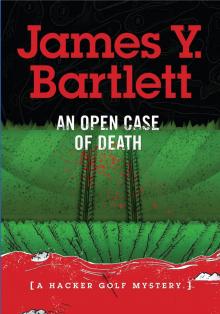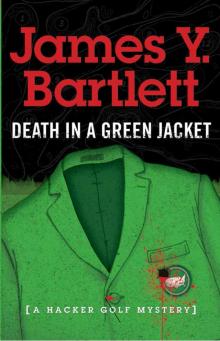- Home
- James Y. Bartlett
P.G.A. Spells Death Page 4
P.G.A. Spells Death Read online
Page 4
Still, it’s a wonderful city to wander through on foot, and eventually you get down to the waterfront, where the old cotton warehouses overlooking the steadily flowing green-gray water of the Savannah River—coming down from Augusta and flowing out past Tybee Point into the Atlantic—now contain tourist shops, shrimp restaurants, boutiques, crab cake restaurants, boozy country music bars, a hotel or two, and a long, cobblestoned boulevard where an unsuspecting or drunk tourist can easily turn an ankle.
The grid-like street design of the city was the brainchild of its founder, the British General James Edward Oglethorpe, whose concept for the colony of Georgia he founded was to provide a place for all the men stuck in debtor’s prison back in London to come start a cotton farm and become fabulously wealthy. Good idea, but a bit ahead of its time, so Gen. Oglethorpe went back to Britain and helped defeat Bonnie Prince Charlie in the Rising of the ‘45.
A hundred years later, Savannah managed to avoid the torch from General Sherman, at the end of his long march downstate from Atlanta, who, instead of burning the place down, begged Mr. Lincoln to allow him the honor of presenting him the city as a Christmas gift back in 1864. Once that bit of unpleasantness was out of the way, Savannah slowly drifted into sleepy backwaterdom, its citizens drank, screwed and intermarried each other and the city threatened to rot away in the hot Georgia sun until an urban renovation movement took hold in the 1970s and turned the city into the tourism mecca it is today.
At mid-morning I went out to look at the Savannah Golf Club on President Street, separated from the Savannah River by acres of shipping and container facilities. They claim the club was founded back in 1792, which would make it almost a hundred years older than what the USGA claims is the country’s oldest golf club (St. Andrews, Yonkers, New York, 1888). The place reeked of old money and the current golf course, which actually dates from 1899, looked flat and boring, except for all those nice liveoak trees with their gnarled limbs draped in Spanish moss.
I parked my rental car and wandered around the back of the elegant brick clubhouse. There were rows of glistening green carts set out waiting for members to come and play, overseen by an elderly gentleman with ebony skin and white hair, working at a stand shaded by an umbrella.
“Heard this place has some history to it,” I said when I walked up to him.
“Oh, yassuh,” he said, nodding and smiling. “Plenty o’ that ‘round these parts.”
“Is this where Bagger Vance was a caddie?”
He chuckled, low and deep from his throat.
“Now, don’t you go talkin’ ‘bout that piece of mess,” he said. “Them movie fellers don’ always tell you the truth straight up.”
“So Will Smith never worked here, huh?”
The man smiled at me, his teeth bared.
“They was one part of that movie, where Massa Smith was a sittin’ on the clubhouse steps sippin’ hisself some nice ice tea,” he said. “If’n he done that back in 19 and 31, he woulda found hisself hangin’ from yonder trees.” He nodded down the fairway. “True dat.”
“Never thought about that,” I said.
“Uh huh,” the man said, shaking his head sadly.
A car pulled to a stop in the nearby bag drop area, and my friend shuffled over to help them unload their clubs. I looked around at the opening and closing holes, lying empty in the hot morning sun. I took in a big breath of air. It smelled of sulfur. Not because of the history lesson I had just received. It was the smell from one of the big paper processing plants on the outskirts of town. ‘The Southern smell of money’ an old friend of mine had once described the odor found throughout the Lowcountry where pine trees are turned into newsprint, paper towels and toilet paper.
“Can I help you, sir?” came a voice behind me. I turned. The voice belonged to a pleasant-looking man, about 50, who looked like a golf professional. Maybe it was the well-pressed polyester sans-a-belt trousers or the Savannah Golf Club logoed shirt or the FootJoy spikeless teaching shoes in a nice two-tone saddle style. Or maybe it was the official plastic name tag pinned over his heart, which said “Clark.”
I stuck out my hand. “Hacker,” I said. “I’m with IBS. Doing a little historical research for this weekend’s telecast.”
“Welcome to the club, Mister Hacker,” Clark said. He looked behind me, toward the parking lot. “You come with a crew?”
“Nah,” I said. “Just me. Scouting some locations.” I wasn’t sure what that meant. But it sounded official.
Clark nodded. “Got just the thing,” he said. “C’mon.”
He jumped into one of the golf carts and motioned for me to join him. “Clark Vickers,” he said as we tooled silently away from the clubhouse and headed out onto the course. “I’m the head pro.”
The course was tree-lined and mostly flat. As we circled a few of the greens, I noticed they were mostly raised and table-topped, falling away in all directions.
“Looks like Donald Ross was here,” I said, referring to the famous Scottish-born architect who worked in golf’s first Golden Age, around the turn of the last century.
“Good eye,” the pro said. “He re-did this course around 1927. He did a lot of work here in Savannah.”
“Who laid the place out in 1792?”
He laughed. “I like to think it was General Oglethorpe himself,” he said. “But nobody remembers. Probably just some of the members filled with grog knocking their balls around a field.”
He pulled the cart into a woodsy copse between two holes. I could hear the traffic from busy President’s Street nearby.
He pointed. “You see that raised hump over there? How it extends a bit towards the south? “ I looked, and could make out the shape he was talking about, covered with some shrubs and a few medium size trees. “That was a Confederate earthworks line,” he said. “Just north of us was Fort Boggs, which had a pretty big artillery battery to guard the river approach from the east. The earthworks line extended down through here, hooked up at another fort to the south of us, and then circled back around to protect the southern flank of the city.”
“Guess it didn’t stop Sherman,” I said.
“Naw,” Clark said. “He came in from the southwest. He captured Fort McAllister down on the Ogeechee River in about fifteen minutes and that was about that. The Union navy was anchored offshore, waiting to sail in and start bombarding, and the Confederate generals decided to take their troops up into the Carolinas and live to fight another day. When the Union troops marched in, we offered everyone a Planter’s punch, it being Christmas and all. Sherman thought that was nice, so he decided not to burn the place to the ground, like he did in Atlanta. There are some very wealthy real estate agents in these parts who are very glad our city fathers rolled over. Saved ‘em a helluva lot of excellent downtown inventory.”
I laughed.
“I was talking with your cart man about Bagger Vance,” I said. “He didn’t seem to have too high of an opinion about the movie.”
“Oh, that film was interesting in its own way,” Clark said. “But historically speaking, total crap. It was a retelling of an ancient Hindu myth, and they actually did most of the filming up on Hilton Head.”
We got back in the cart and headed to the clubhouse.
“Now if you want some real historical figures, there’s Gene Sauers and Hollis Stacy,” he said. “Both from Savannah and both played their junior golf here at this club. Did fairly well on their respective tours.”
I jotted down the names. “I remember Gene,” I said. “I think he played before me in college.”
“Hollis won the women’s Open three times, which is pretty damn good, you ask me,” he said. “Came from a big family, ten kids. Her younger sister Martha won the Mid-Amateur, played in it for years and years. Pretty strong golfing family.”
He was silent for a moment as we zipped along the cart path.
“True story,” he said. “Back in those days, the club wouldn’t let kids out
on the course on their own, except for certain times. So Hollis, Gene and the other kids would chip and putt a lot instead. When Hollis was inducted into the World Golf Hall of Fame, she thanked the members of the club for giving her a great short game!”
I laughed. “Funny,” I said. “And good material.”
Vickers dropped me off at the clubhouse. We shook hands and I drove back into town. It was just after noon, but I took a chance on getting in to Mrs. Wilkes Boarding House on West Jones. People start lining up in the morning to have lunch at this place, where the seating and the service is all family style: you sit down at a large table with lots of other strangers and everyone passes around the food: barbecue pork, fried chicken, meatloaf, plus dishes of mac n’ cheese, candied yams, collard greens, butter beans, rice and gravy, pickled beets, cole slaw and more, all washed down by huge icy glasses of sweet tea.
I was lucky enough to get in with the last bunch of lunchers, and stuffed myself silly. The people who have lived in this town for generations now may be crazy as hell, but they do know how to eat well.
Once I was loaded up with Southern comfort food, I staggered my way back to the big hotel on the waterfront where we were staying, managed to hit the correct button on the elevator and fell into my bed for the rest of the afternoon.
6
That night, Ben Oswald took his announcer crew out to dinner. I got a call in my room at about five thirty inviting me to join them.
Outside the hotel’s entrance was a big white bus-like vehicle, with green lettering along the side reading Lowcountry Tours. There was no one sitting inside, so I went back into the hotel and checked the lobby bar. Three of the guys were standing at the bar, feet resting on the brass rail, sipping cocktails while the TV set behind the bar showed the day’s sports highlights.
“Hack-man!” one of the guys at the bar called out to me when I walked in.
“Hey, Jimmy,” I said, and went over to greet Jimmy Williams, the main color announcer at IBS. Jimmy had played on the Tour for about fifteen years before a shoulder injury sent him up to the booth. He had won a PGA Championship along with a handful of Tour events and had starred in a couple Ryder Cups. He worked the booth on the 18th hole along with his TV announcer partner, Van Collins, who was standing next to Jimmy at the bar.
“Hacker, you know Van, right?” Jimmy said, nodding at the man next to him, “And this is Billy Fairfield, the Voice of the Par Threes.”
I shook hands all around. Jimmy Williams was now in his late forties but still had that flatbelly look of the former professional golfer. He also had a bushy head of blond hair cut improbably in an old mullet, which had been popular back before he starting playing on the Tour. I was surprised no one had ever told him he looked dated and stupid, but then again, it was only a haircut. His do must cost a fortune at the salon—because who does mullet cuts anymore?—but then, he could probably write it off as a tax deduction.
Van Collins was maybe twenty years older. He had been announcing sports for IBS for a generation at least. His familiar baritone had called college football, professional baseball and hockey games for the network before he moved over to handle the golf broadcasts some ten years ago. He was known as a pro’s pro…always hitting his marks, seamlessly moving the telecasts between commercials, promos and live action. He was dressed in golf casual, a sweater tossed over his shoulders and his hair turned mostly to white. He had been nursing a tall Scotch at the bar, and after a desultory handshake and wan smile, he went back to it.
Billy Fairfield was tall and wiry with rimless glasses and eyes that never stopped darting around the room. He, too, smiled and shook my hand, but held back a bit. He seemed to be taking his cues from whatever Van Collins did.
“When did you get into town?” Jimmy asked me.
“Couple days ago,” I said. “I’ve been scouting the town.”
“Well, shit,” Jimmy said. “You shoulda called me. I could have used a better partner today than old Van here. Jeezus, Collins, how many three-putts did you have?”
“Kiss my ass,” Van said, not turning away from his Scotch, as if he were worried it would run away and hide if he took his eyes off it.
“Where’s the rest of the motley crew?” I asked.
“Oh, they’ll be down,” Jimmy said. “Oswald likes to be fashionably late.”
“Up yours, Williams,” said a brash voice at the door, and we all turned to see the Assassin, Ben Oswald himself, standing there. “How many goddam drinks you had already?”
“Not enough, Ben, not nearly enough,” Williams said.
Oswald was wearing black jeans, a white Oxford shirt open at the collar and a pair of cowboy boots. He stared at me through his thick glasses. “I see you got the message,” he said to me. “You know all these guys?”
Before I could answer, someone came around from behind Oswald. She was short, she was rounded in all the right places and she was quite blond, in a color not usually found in nature. She tossed her locks back with a flip of her head and came walking right over to me, hand extended.
“I don’t think I’ve had the pleasure,” she said. “I’m Kelsey Jenkins. Nice to meet you, Hacker.”
I shook her hand, and didn’t mention that we had met some years ago that weekend I covered the LPGA event down in Miami. The weekend that ended with the murder and suicide of Big Wynnona Stilwell and her husband Harold. I figured Kelsey had been so traumatized by those events that she had forgotten meeting a stud muffin like myself.
Kelsey had joined the IBS crew a couple of years ago. And while some of the old timers thought adding a female voice to the weekend broadcasts of men’s golf was sacrilegious, the viewers got used to watching her work. Oswald most of the time sent her out to follow one of the leading groups and do the fairway reporting—checking the lie, checking the distance, predicting the shots to come. Other times, he sent her to work one of the towers on the concluding holes. Either way, she had turned out to be a competent and interesting announcer.
“We all here?” Oswald said, looking around.
“Waiting on Parker,” Jimmy said with a laugh. The others all smiled. He looked at me. “There’s always one straggler,” he said, “And ours is Parker Long.”
“Is Kenny Craig not coming?” Van Collins piped up from the bar.
“Oh, yeah, the Professor,” Oswald chortled. “Can’t forget him.”
“I’m right here,” said another voice, and Craig walked in. Short and a bit on the pudgy side, Craig was the main swing analyst, the master of slo-mo, the guy who could dissect someone’s swing right down to the toenails. In addition to his work with the network, Kenny Craig worked as a swing coach with a half dozen or so Tour players. He knew a lot about the golf swing, hence his moniker.
“OK, everyone into the bus,” Oswald said. “If Parker doesn’t show up in five minutes, we’re leaving him.”
The guys at the bar settled their tab and we all walked back outside. Kelsey Jenkins fell in next to me and whispered “He always says that, but he’s never left anyone behind for dinner.”
We filed into the bus and everyone took a seat. The bus held about forty seats, so there was plenty of room. Once we were all seated, the bus driver cranked up the engine and revv’ed it a few times. As if on cue, Parker Long came out of the hotel, looking a bit rushed, and swiftly got on board. We all rewarded him with a round of derisive applause. The driver pulled the door closed and pulled away.
“Right,” Oswald called out. “I hope you all like seafood, ‘cause we’re going to a place that serves the best in the South. It ain’t fancy, but, well, you’ll see.”
The bus driver followed Abercorn through the heart of the historic district, passed by Forsythe Park and its huge, multi-layered fountain spewing white foamy water, and took a left to the east on Victory Drive. There were still some large brick mansions facing on Victory, but the houses in the neighborhoods behind looked more like normal-sized suburban ranches.
We dr
ove past an area filled with the usual mix of big box stores, through a few more suburban neighborhoods and then, just before the road crossed a bridge over the Wilmington River, turned hard right down a narrow little road on a bluff above the river. A little bit further down, we passed a sign that said Welcome to Pinpoint.
“Anybody know the most famous person who hails from Pinpoint, Georgia?” Ben Oswald called out from the front of the bus. “How about you, history boy?”
He was, of course, referring to me. Luckily I knew the answer.
“Unless you’re thinking of someone else, I’d say it has to be Supreme Court Justice Clarence Thomas,” I said.
“Give that man a cigar!” Oswald said.
The bus slowed down to a crawl. The street was barely wide enough for the bus and the verges were covered in white beach sand mixed with crushed oyster shells. To the right, we passed some scruffy looking one-story houses, shaded by the trees, yards encased in chain link. To the left, the greenish water of the river seemed still. Along the bank in the distance were some weathered wooden docks crowded with working shrimp boats, their derrick arms raised upright and their nets hanging neatly. Looking out over the marshes from the road, I felt I was in central Kansas: the horizon stretched out endlessly over the brown and green grasses, broken here and there by collections of trees that indicated where higher land had survived amid the eternal tidal flows.
“This is a workingman’s town,” Oswald said. “The open ocean is maybe five miles thataway…” he pointed to the east, “…but to get there, the boats gotta run about ten miles through the marshes, following the green snake. But be glad they do, because the shrimp and crabs they serve at this place probably arrived at the docks an hour or so ago.”
The bus pulled up in front of a gray house with a sign that announced it as Fiona’s Seafood Shack. It looked kinda shacky, with some white plastic tables and chairs set on a patio in front.

 P.G.A. Spells Death
P.G.A. Spells Death Death from the Ladies Tee
Death from the Ladies Tee An Open Case of Death
An Open Case of Death Death is a Two-Stroke Penalty
Death is a Two-Stroke Penalty Death in a Green Jacket
Death in a Green Jacket Death at the Member Guest
Death at the Member Guest